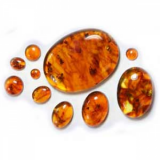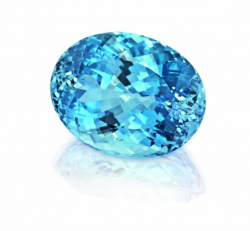What's the meaning of the Peridot »
Peridot
This page is about the meaning, origin and characteristic of the symbol, emblem, seal, sign, logo or flag: Peridot.

Like many gemstones, the peridot possesses a number of different symbolic meanings.
Compared to some of its gemstone cousins, pinning down the historical significance and symbolic meaning of peridot is an unusually tricky business. Even the origin of this stone's name is uncertain: Candidates include the Arabic “faridat” (meaning ‘gem’), the French “peritot” (meaning ‘unclear’), and the Greek “peridona” (meaning ‘to give richness’). The Hebrew word “pitdah” has also been cited as a possible root. Two things are known for sure, however; peridot gets its characteristic oily green color from the mineral olivine, and that the stone was used as ornamentation by some of the world's earliest civilizations.
For over 3500 years, peridot has been mined from a small island in the Red Sea, off the coast of Egypt. Today it is known as St. John’s Island, but historically it has been called by many other names, including Zabargad, Zebirget and Topazios. The last of these names is another indicator of the trickiness involved in definitively pinning down peridot. The ancient Greeks called this stone “topazos”, from which our modern word “topaz” - as well as the latter name of the island - is derived. For a long time, this linguistic confusion caused peridot to be mistakenly identified as topaz (a completely different substance), and it wasn’t until the 18th century that the stone we now know as topaz was properly assigned its name.
Regardless of linguistic confusion, peridot has held great symbolic importance over the centuries. The ancient Egyptians (partly due to the topaz misconception, in fact) viewed the stone as symbol of the sun, and both the Egyptians and Romans used it to carve various types of amulets. For the ancient Hebrews, peridot was one of twelve gemstones set into the breastplate of the High Priest of ancient Israel, an object believed to the originator of the modern concept of birthstones.
During the Middle Ages, returning Crusaders brought peridot from St. John’s Island back to Europe, where it acquired a whole new set of symbolic meanings: Many gemstones have been assigned positive medicinal effects over the centuries, and peridot was believed to help cure liver problems, sooth sore muscles, and bring cheerfulness to the wearer by helping to dispel nightmares.
Deposits of peridot are also found on the Hawaiian Islands, and the native population has traditionally held the stone in high regard. Peridot is an igneous rock- meaning it was formed by volcanic activity- and since volcanoes are such a defining feature of the islands, it makes sense that the stone would hold high status. To the Hawaiians, peridot was believed to be the tears of the fire goddess Pele (pronounced “Pay-lay”).
Peridot is also the traditional birthstone for the month of August.
- 1,149 Views
Graphical characteristics:
Asymmetric, Closed shape, Colorful, Contains straight lines, Has crossing lines.
Categories: Gemstones and Natural Substances, Miscellaneous.
More symbols in Miscellaneous:
Symbols without any special category attribution but that are widely used worldwide. read more »
More symbols in Gemstones and Natural Substances:
In addition to plants, animals, and geographic features and phenomena, the natural world is home to a vast array of materials and substances that all carry symbolic meaning. This meaning may be rathe… read more »
Citation
Use the citation below to add this symbol to your bibliography:
Style:MLAChicagoAPA
"Peridot." Symbols.com. STANDS4 LLC, 2024. Web. 26 Jul 2024. <https://www.symbols.com/symbol/peridot>.













Have a discussion about Peridot with the community:
Report Comment
We're doing our best to make sure our content is useful, accurate and safe.
If by any chance you spot an inappropriate comment while navigating through our website please use this form to let us know, and we'll take care of it shortly.
Attachment
You need to be logged in to favorite.
Log In